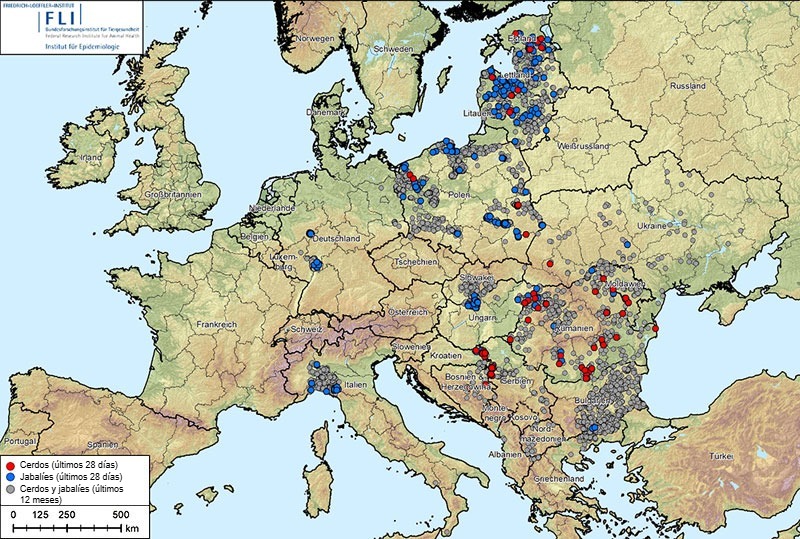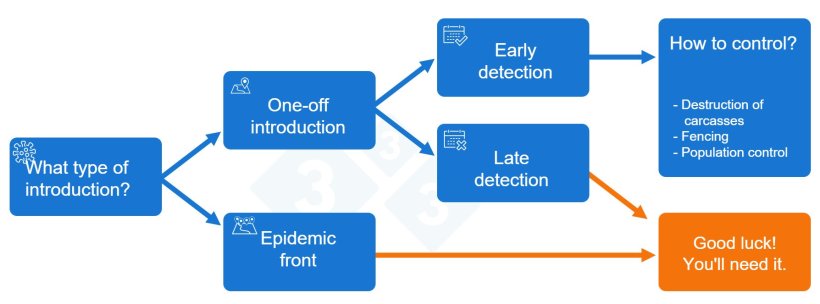Three years ago, 333 launched a survey to assess the industry's perception of the risk of African swine fever (ASF) entering the country. In 2022, 65% of the survey participants assumed that ASF was an imminent risk and believed that the virus would arrive in less than three years. However, for certain countries, the question is not whether it will arrive, but when. Therefore, being prepared remains essential. This article reviews the current situation in Europe, the key mechanisms of transmission, the measures that have worked, and the preparedness measures in response to the threat of ASF.
Current ASF situation: the largest spread in history
ASF has never been so widespread globally. In the European Union, 13 Member States are now affected. Although countries such as Belgium and Sweden have managed to eradicate the virus after its initial detection, the disease continues to gain ground in other regions. In 2024, more than 14,000 cases were reported in wild boars, and although reports of outbreaks in domestic pigs decreased by 83%, farms continue to be affected, especially small farms in southeastern Europe. And the virus is spreading westward (Figure 1).


Figure 1. Outbreaks of African swine fever (genotype II) in Albania, the Baltic States, Bosnia and Herzegovina, Bulgaria, Germany, Greece, Italy, Kosovo, Croatia, Moldova, Montenegro, North Macedonia, Poland, Romania, Sweden, Serbia, Slovakia, Czech Republic, Ukraine, and Hungary (August 20, 2024, to August 20, 2025). Data source: ADIS, TSN (as of August 20, 2025, 8:40 a.m.)
How ASF spreads
ASF spreads through two main routes: naturally, which is slower but constant, or mediated by human action, which is much faster, unpredictable, and difficult to contain.
Natural spread occurs among wild boars, which act as a reservoir. One example is the spread of the virus throughout the Baltic region. The natural movements of wild boars in search of food or during reproductive behavior facilitate the spread of infection. The environment plays a decisive role in this dynamic.
Factors that directly influence the direction and speed of spread include:
- The presence of barriers: large rivers, urban areas, road infrastructure, etc.
- The availability of food.
- The type of vegetation cover.
- The season of the year.
At very short distances (<500 m), even mechanical vectors such as stable flies (Stomoxys calcitrans) could play a role. In any case, natural spread does not exceed 15-30 km per year, meaning it is very slow.
Any new case occurring more than 100 km from an infected area will most likely be due to human action.
Human-mediated spread is a transmission route that is difficult to predict and is capable of carrying the virus to, for example, the island of Hispaniola (Dominican Republic and Haiti) in the Caribbean.
ASF introductions by human activity occur mainly in two ways:
- The transport of wild boars or live pigs.
- The transport of meat products or other infected materials.
Do we know how the virus entered? Rumors
It is very difficult to identify the specific cause of each introduction of the virus, although there are often unverifiable speculations, for example:
- Georgia, 2007: Attributed to food scraps from ships arriving from Africa, which could have been used to feed backyard pigs.
- Czech Republic, Zlín, 2017: Rumors point to infected food scraps, presumably from an Eastern European country, which were accessed by wild boars living on the outskirts of towns.
- Belgium, 2018: This unexpected outbreak may have been caused by the illegal importation and release of wild boars from Poland.
- Sweden, 2023: Associated with a landfill in a rural area, which wild boars had access to.
The maritime route poses a real threat. In addition to the case of Georgia, we must consider the possibility that the virus reached Genoa (Italy) via international maritime traffic. Countries with maritime infrastructure should not underestimate this risk.
ASF control measures in wild boar
European experience shows that controlling ASF in wild boar populations is possible, but it requires extraordinary effort. The scenarios with the highest probability of success share three key conditions:
- A one-off introduction of the virus.
- Early detection.
- An immediate and well-coordinated response.
Sweden managed to eradicate the disease thanks to early detection and the immediate implementation of measures such as strategic hunting, systematic disposal of infected carcasses, rapid deployment of fences to restrict animal movement, and reinforced biosecurity on pig farms.
Control becomes much more complex if:
- ASF is advancing in the form of an epidemic front, as in the Baltic countries.
- There are multiple independent points of entry, as in Italy.
- Detection is delayed.
In these cases, intervention measures lose their effectiveness, management is prolonged, and costs increase significantly (Figure 2).

Figure 2. Decision tree for responding to the introduction of African swine fever (ASF)
What new tools can we expect?
Although there are promising projects for developing vaccines against ASF, progress has not yet led to a solution that will be available in the short term. The same is true of GnRH immunosterilization, which has been proposed for population control in wild boars. Despite its theoretical advantages, the fact that immunosterilization must be administered individually and by injection makes it an unviable option in wildlife, where populations are numerous, dispersed, and difficult to access.
The integration of technologies such as camera trapping, telemetry, and even the use of drones is opening up new possibilities. These tools provide essential data on the density, connectivity, and movement patterns of wild boars, facilitating more informed decision-making tailored to the epidemiological context.
Seeing what has happened in recently infected countries, the obvious question is: Are we prepared for this threat? We will devote our next article to this topic.





